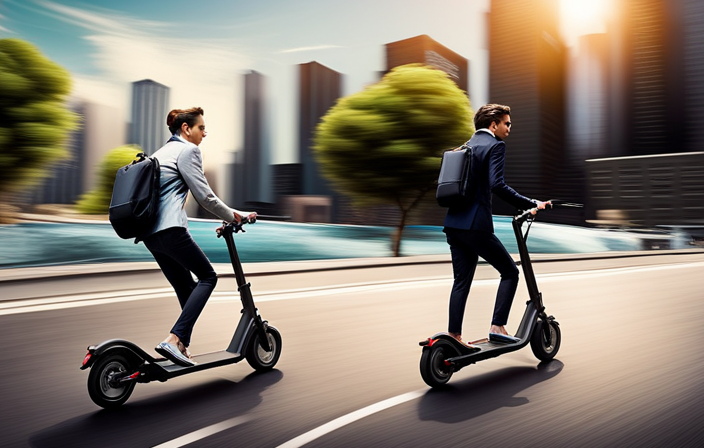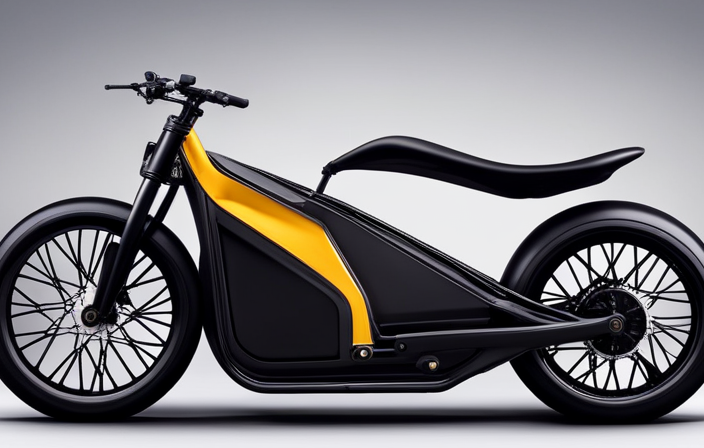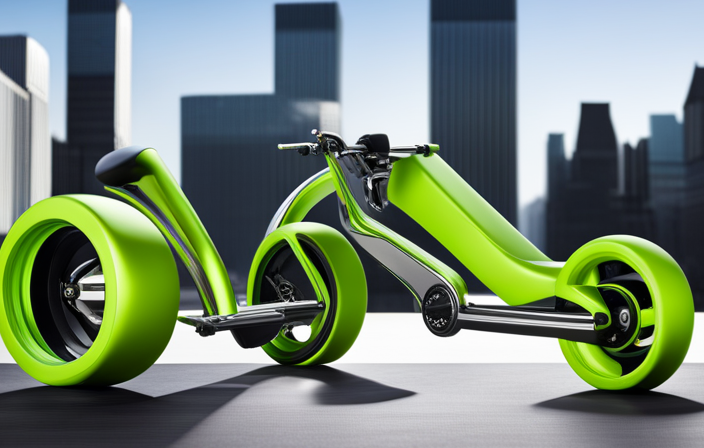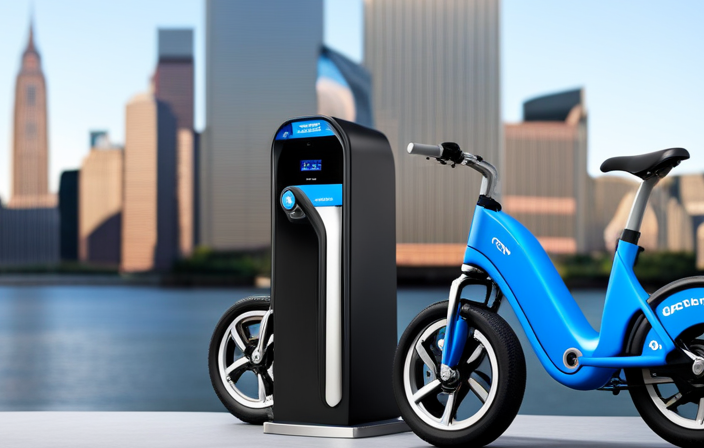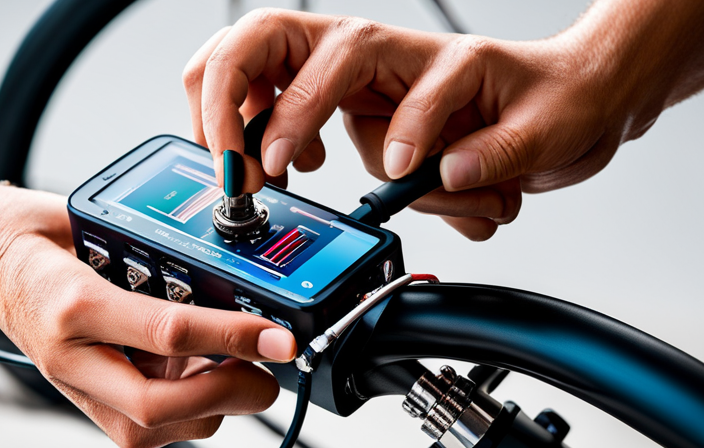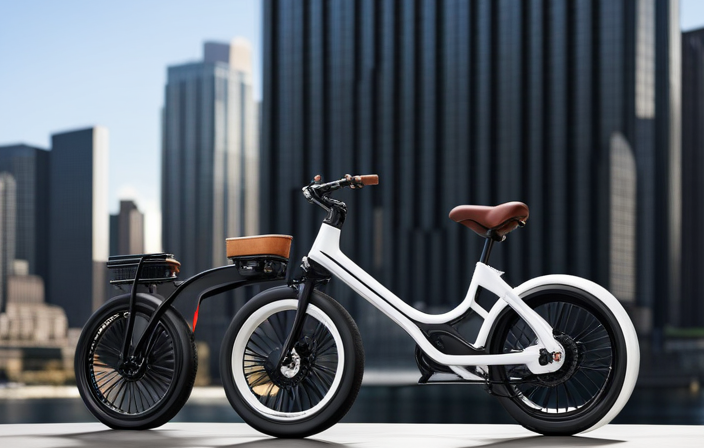Are you tired of sitting in traffic or waiting for public transportation? Well, fear not! I have discovered a solution that will revolutionize your daily commute and give you a newfound sense of freedom and convenience.
In this article, I will guide you through the process of choosing the perfect electric scooter or electric bike in just three easy steps.
So, get ready to embark on a journey of electric mobility and discover the joy of zipping through the streets with ease.
Key Takeaways
- Consider daily commute distance, terrain, and desired speed
- Read reviews and ratings from other users, compare features and specifications, and look for trusted and reliable brands with a good reputation
- Evaluate factors like speed, range, and battery life, choose the right size for comfort and maneuverability, and consider weight, dimensions, and adjustable features
- Check for LED lights and reflectors for enhanced visibility, consider disc brakes or anti-lock braking systems for better control, and look for additional safety features like horn and turn signals.
Determine Your Needs and Preferences
You’ll need to determine your needs and preferences before choosing the right electric scooter or electric bike. Factors to consider include your daily commute distance, terrain, and desired speed.
If you plan to use it for short trips around the neighborhood, a scooter with a lower top speed may suffice. On the other hand, if you have a longer commute or need to tackle hilly terrain, an electric bike with a higher top speed and better suspension might be more suitable.
Additionally, personal preferences such as design, color, and comfort should also be taken into account. Once you have a clear understanding of what you need and what you like, you can transition to the next step of researching different brands and models to find the perfect electric scooter or electric bike for you.
Research Different Brands and Models
When researching different brands and models of electric scooters or electric bikes, it’s important to read reviews and ratings from other users. This will give you valuable insights into the performance and reliability of the product.
Additionally, comparing features and specifications will help you determine which model best suits your needs and preferences.
Lastly, it’s advisable to look for trusted and reliable brands that have a good reputation in the market. This ensures a higher level of quality and customer satisfaction.
Read Reviews and Ratings
To find the right electric scooter or electric bike for you, start by checking out reviews and ratings. This step is crucial in making an informed decision about your purchase. Reviews and ratings provide valuable insights from other customers who have already experienced the product.
Here are some reasons why reviews and ratings are important:
- They offer unbiased opinions about the pros and cons of different brands and models.
- They help you understand the performance, durability, and reliability of the electric scooter or electric bike.
- They give you an idea of any potential issues or drawbacks to consider before making your purchase.
- They can help you spot fake reviews and ratings, ensuring that you are getting genuine and trustworthy information.
By reading reviews and ratings, you can gather valuable knowledge and make an educated decision. Once you have done this, the next step is to compare features and specifications to further narrow down your options.
Compare Features and Specifications
Comparing features and specifications allows me to make a more informed decision about the electric scooter or electric bike that best suits my needs. By conducting a performance comparison, I can evaluate factors such as speed, range, and battery life to determine which model will provide the optimal riding experience.
Additionally, choosing the right size is crucial for comfort and maneuverability. Considering factors like weight, dimensions, and adjustable features can help me find the perfect fit.
By comparing these features and specifications, I can narrow down my options and select a model that meets my requirements. Once I have gathered this information, I am ready to move on to the next step and look for trusted and reliable brands that offer the electric scooter or electric bike I desire.
Look for Trusted and Reliable Brands
After comparing features and specifications, it’s important to consider trusted and reliable brands. When choosing an electric scooter or electric bike, opting for a reputable brand can make a significant difference in terms of quality and performance. Trusted brands often have a track record of delivering innovative and reliable products. One way to compare features between trusted brands is to create a table that showcases the key specifications, such as motor power, battery range, and maximum speed. Additionally, it’s crucial to take into account customer reviews during brand selection. Reading about other customers’ experiences can provide valuable insights into the overall satisfaction and reliability of a particular brand. By considering trusted brands and customer reviews, you can make a more informed decision when selecting your electric scooter or electric bike. This will ensure that you are investing in a reliable and high-quality product that meets your needs. In the next section, we will discuss how to test ride and evaluate different models.
Test Ride and Evaluate
When you’re ready to make a decision, take the electric scooter or electric bike for a test ride and evaluate its performance.
Testing a potential purchase is essential to ensure it meets your requirements and expectations. By taking it for a spin, you can experience firsthand the benefits of a test ride.
Not only can you assess its speed, acceleration, and maneuverability, but you can also get a feel for the overall comfort and stability of the ride. Pay attention to how the scooter or bike handles different terrains and turns. Evaluate its braking system and responsiveness. Additionally, take note of any noise or vibrations that may indicate potential issues.
Once you’ve thoroughly tested and evaluated the performance, it’s time to consider battery life and range for your desired mode of transportation.
Consider Battery Life and Range
Battery life and range are important factors to consider when deciding on an electric scooter or electric bike. The battery capacity determines how long you can ride before needing to recharge, while the range indicates the maximum distance you can travel on a single charge.
When considering battery life and range, you should take into account your daily commuting needs. If you have a short commute, a scooter or bike with a smaller battery capacity may suffice. However, if you have a longer commute or plan on using your electric vehicle for longer trips, it’s recommended to opt for a higher battery capacity and a longer range.
Additionally, consider the charging time of the battery. Some models may take longer to charge fully, while others have quick charging capabilities. This can be crucial if you need to recharge your electric vehicle during the day or if you have limited time to wait for it to charge.
Considering battery life, range, and charging time will ensure that you choose an electric scooter or electric bike that meets your specific needs and provides a convenient and enjoyable riding experience.
Now, let’s delve into the next section and explore the safety features to look for.
Look for Safety Features
When considering safety features for an electric scooter or electric bike, it’s important to check for LED lights and reflectors. These can greatly enhance visibility, especially during night rides or in low light conditions.
Additionally, looking for disc brakes or anti-lock braking systems can provide better control and stopping power, ensuring a safer ride.
Finally, it’s worth considering additional safety features such as a horn or turn signals, which can further enhance communication and alert others of your presence on the road.
Check for LED Lights and Reflectors
LED lights and reflectors are important features to consider when choosing the right electric scooter or electric bike. Comparing safety features is crucial in ensuring a secure ride.
LED lights provide enhanced visibility, allowing you to be seen by other road users during low light conditions. They also illuminate the path ahead, ensuring a clear view of any obstacles.
Reflectors further enhance your safety by reflecting light from other sources, making you more visible from various angles.
Evaluating durability and build quality is equally important. Look for high-quality LED lights and reflectors that are resistant to water and shock, ensuring they can withstand different weather conditions and vibrations.
These features not only enhance your safety but also contribute to the overall longevity of the scooter or bike.
Now, let’s move on to the next section and explore the importance of disc brakes or anti-lock braking systems.
Look for Disc Brakes or Anti-lock Braking Systems
One important feature to consider is whether the scooter or bike is equipped with disc brakes or an anti-lock braking system. These braking systems provide numerous benefits and are essential for ensuring your safety while riding. Here are some reasons why you should prioritize them:
-
Enhanced stopping power: Disc brakes and anti-lock braking systems offer superior stopping power compared to traditional brake systems, allowing you to come to a halt quickly and safely.
-
Improved control: These braking systems provide better control over your scooter or bike, especially in emergency situations, preventing skidding or loss of control.
-
Benefits of regenerative braking: Some electric scooters and bikes have regenerative braking, which helps recharge the battery while you brake, increasing your overall range.
-
Importance of brake maintenance: Disc brakes and anti-lock braking systems require regular maintenance to ensure optimal performance and safety.
Considering these factors, it’s crucial to select a scooter or bike with reliable braking systems.
Now, let’s explore additional safety features like horns and turn signals that you should also consider.
Consider Additional Safety Features (Horn, Turn Signals, etc.)
To ensure your safety while riding, it’s important to consider additional safety features such as a horn and turn signals. These features provide several advantages that can greatly enhance your riding experience.
Having a horn allows you to alert pedestrians and other vehicles of your presence, helping to prevent accidents. Turn signals are essential for indicating your intentions to other motorists, ensuring a smooth flow of traffic and reducing the risk of collisions.
These safety features are especially important in electric scooters or bikes, as they are often quieter and less noticeable on the road. By incorporating a horn and turn signals, you can significantly increase your visibility and overall safety.
Now, let’s move on to evaluating the maintenance and warranty of your prospective electric scooter or bike.
Evaluate Maintenance and Warranty
When evaluating maintenance and warranty for electric scooters or electric bikes, it is important to research the maintenance needs and costs associated with the specific model you are considering. This will help you understand if there are any ongoing expenses or specialized services required.
Additionally, checking for warranty coverage and support is crucial to ensure that you are protected in case of any defects or issues with your purchase.
Lastly, reading customer experiences and feedback can provide valuable insights into the overall reliability and durability of the product, giving you a better understanding of what to expect in terms of maintenance and warranty.
Research Maintenance Needs and Costs
Make sure you research the maintenance needs and costs of electric scooters or electric bikes. It’s important to understand what kind of maintenance these vehicles require and how much it will cost you in the long run.
Electric scooters and bikes have different maintenance needs compared to traditional gasoline-powered vehicles. For example, you may need to regularly check and replace the battery, tires, and brake pads. Additionally, you should consider the costs of routine maintenance such as oil changes, tune-ups, and repairs.
By understanding the maintenance needs and costs, you can make an informed decision about which electric scooter or bike is right for you.
Once you have evaluated the maintenance needs and costs, it’s important to also check for warranty coverage and support, which will be discussed in the next section.
Check for Warranty Coverage and Support
After researching the maintenance needs and costs of electric scooters and electric bikes, it’s vital to consider warranty coverage and support. This step is crucial in ensuring that you are protected in case of any unforeseen issues or defects with your new electric ride.
When checking for warranty coverage, it’s important to understand the specific terms and conditions, such as the duration and what it covers. Additionally, assessing the customer service quality is equally important. A helpful and responsive customer service team can make all the difference when it comes to resolving any warranty claims or addressing any concerns you may have.
Now, let’s move on to the next step and read customer experiences and feedback to make an informed decision about the right electric scooter or electric bike for you.
Read Customer Experiences and Feedback
Reading customer experiences and feedback can provide valuable insights into the performance and reliability of different electric scooters and bikes. It is important to take the time to research and read reviews from other customers before making a decision.
Customer reviews can help you understand the pros and cons of a particular model, as well as any common issues or concerns. By reading about other people’s experiences, you can get a better idea of how the scooter or bike performs in real-life situations. This information is especially helpful when it comes to determining the durability and longevity of the product.
Taking into account customer feedback can help you make an informed decision and avoid potential disappointments.
Now, let’s consider the next factor to consider: portability and storage.
Consider Portability and Storage
When considering portability and storage, it’s important to think about the size and weight of the electric scooter or electric bike. Portability is crucial because you may need to carry or transport your scooter or bike in various situations, such as when using public transportation or storing it in a small apartment. Look for models that are lightweight and compact, making them easier to handle and store.
Additionally, consider the storage and space requirements of the scooter or bike. Some models may fold or have detachable parts, allowing you to save space when not in use.
Now that you have thought about portability and storage, it’s time to check local regulations and laws to ensure you can ride your electric scooter or bike legally and safely.
Check Local Regulations and Laws
When choosing an electric scooter or electric bike, it’s crucial to check the local regulations and laws in your area. Researching the electric ride laws will help you understand the specific rules and restrictions you need to follow.
Additionally, you must determine if a license or registration is required for your chosen vehicle and ensure compliance with speed and safety regulations. By doing so, you can confidently enjoy your electric ride while staying within the legal boundaries of your community.
Research Electric Ride Laws in Your Area
To choose the right electric scooter or electric bike for you, make sure you research the electric ride laws in your area. It is essential to understand the regulations surrounding electric ride sharing and how they may impact your choice.
Different cities and states have different rules and restrictions, so taking the time to familiarize yourself with local laws is crucial. Some areas may have specific requirements for speed limits, designated bike lanes, or helmet usage. Additionally, there may be restrictions on where and how you can park or ride your electric scooter or bike.
By researching these regulations, you can ensure that you choose a vehicle that aligns with your local laws and avoids any potential legal issues. Understanding the electric ride laws in your area will help you make an informed decision when selecting the right electric scooter or electric bike for your needs.
Moving on to the next step, it is also important to determine if a license or registration is required.
Determine if a License or Registration is Required
First, find out if you need a license or registration for your electric ride. License requirements for electric scooters and electric bikes vary depending on where you live. Some states or cities may require a valid driver’s license or a special license specifically for electric rides. It’s important to research and understand the specific regulations in your area to avoid any legal issues.
Additionally, certain areas may also require you to register your electric ride. This process usually involves filling out some paperwork and paying a fee. By familiarizing yourself with the license requirements and registration process, you can ensure that you are in compliance with the law.
Now, let’s move on to the next step, which is to ensure compliance with speed and safety regulations.
Ensure Compliance with Speed and Safety Regulations
Make sure you are aware of and follow the speed and safety regulations to stay in compliance with the law. Understanding local laws and regulations is crucial when it comes to electric scooters and electric bikes.
Speed and safety regulations are put in place for the safety of riders and pedestrians alike. They ensure that everyone can enjoy the benefits of these vehicles without compromising their well-being. By adhering to these regulations, you not only avoid legal consequences but also contribute to a safer environment for everyone.
It is important to note that speed limits can vary depending on the area, so familiarize yourself with the specific regulations in your locality. By doing so, you can confidently enjoy the convenience and freedom that electric scooters and electric bikes provide.
Seeking recommendations and advice from experienced riders can further enhance your understanding of these regulations and assist you in making an informed decision.
Seek Recommendations and Advice
Once you’ve gathered recommendations and advice, it’s easier to choose the right electric scooter or electric bike. Seeking recommendations and advice from trusted sources is crucial when making a decision between an electric scooter and an electric bike. Here are some pros and cons to consider:
-
Electric Scooter:
-
Pros: Compact and portable, suitable for short commutes, easy to maneuver in traffic.
-
Cons: Limited range and speed, may not be suitable for longer distances or rough terrains.
-
Electric Bike:
-
Pros: Longer range and higher speed options, suitable for various terrains, provides exercise.
-
Cons: Heavier and bulkier than electric scooters, limited portability.
By seeking recommendations and advice, you can gather valuable insights from experienced riders and experts. This will enable you to make an informed decision when choosing between an electric scooter and an electric bike, ensuring that you select the option that best suits your needs and preferences.
Transitioning into the next section, let’s explore how to make an informed decision when purchasing your electric vehicle.
Make an Informed Decision
When making an informed decision about choosing the right electric scooter or electric bike, it is essential to consider all factors and prioritize your needs.
Think about your daily commute distance, terrain, and desired speed, as well as any additional features or accessories that may be important to you.
Additionally, compare prices and financing options to ensure you are getting the best deal and can afford the purchase.
Lastly, it is crucial to purchase from a reputable retailer or authorized dealer to guarantee the quality, warranty, and after-sales support of your chosen electric scooter or electric bike.
Consider all Factors and Prioritize Your Needs
First, think about all the factors and prioritize your needs when choosing the right electric scooter or electric bike. It’s important to consider various aspects such as range, speed, weight capacity, and terrain compatibility. To help you make an informed decision, I have created a table that compares three key factors: range, speed, and weight capacity.
| Factors | Electric Scooter | Electric Bike |
|---|---|---|
| Range | 15-25 miles | 20-40 miles |
| Speed | 15-20 mph | 20-28 mph |
| Weight Capacity | 220-250 lbs | 250-350 lbs |
By prioritizing your needs and comparing these options, you can determine which electric scooter or electric bike suits you best. Once you have considered all the factors, it’s time to move on to the next step: comparing prices and financing options.
Compare Prices and Financing Options
To compare prices and financing options, you can start by researching different retailers and checking if they offer any financing plans. Comparison shopping is essential to ensure you are getting the best deal on your electric scooter or electric bike. Look for retailers that offer competitive prices and promotions. Take note of any additional costs, such as shipping or assembly fees, as these can affect the overall price.
Additionally, consider the financing options available. Some retailers may offer zero-interest financing or flexible payment plans, making it easier to afford your desired electric vehicle. Once you have compared prices and financing options, you can confidently move on to the next step of purchasing from a reputable retailer or authorized dealer, ensuring a smooth and reliable transaction.
Purchase from a Reputable Retailer or Authorized Dealer
It’s important to purchase your electric scooter or electric bike from a reputable retailer or authorized dealer to ensure a reliable and trustworthy transaction. Here are three reasons why:
-
Genuine Products: Authorized retailers have direct access to the manufacturer’s inventory, ensuring that you receive a genuine product with all the necessary warranties and guarantees. This eliminates the risk of purchasing counterfeit electric scooters or bikes that may not meet safety standards or perform as expected.
-
Expert Advice: Authorized dealers have in-depth knowledge about the products they sell. They can provide expert advice on choosing the right electric scooter or bike based on your specific needs and preferences. They can also guide you through the features, specifications, and maintenance requirements, helping you make an informed decision.
-
After-Sales Support: Purchasing from a reputable retailer or authorized dealer ensures that you have access to reliable after-sales support. They can assist with any warranty claims, repairs, or maintenance needs that may arise. This level of support is vital in ensuring that your electric scooter or bike remains in optimal condition for years to come.
To avoid counterfeit products, always verify the retailer’s authorization status and look out for any red flags such as unusually low prices or suspicious packaging. It’s better to invest in a genuine product from a reputable source for your safety and peace of mind.
Frequently Asked Questions
Are electric scooters or electric bikes more suitable for urban commuting?
For urban commuting, electric scooters are more cost-effective than electric bikes. They have lower upfront costs, require less maintenance, and are cheaper to charge. Safety-wise, electric bikes offer better stability and control, making them a safer option.
How long does it typically take to fully charge the battery of an electric scooter or electric bike?
The charging time of an electric scooter or electric bike depends on the battery capacity. Generally, it takes about 4-8 hours to fully charge the battery. Higher battery capacity may require longer charging time.
Can electric scooters or electric bikes be used in hilly areas or off-road terrains?
Yes, electric scooters and electric bikes can be used in hilly areas, but electric scooters are more suitable due to their power and torque. Additionally, electric scooters have advantages in off-road terrains with their sturdy construction and shock absorption capabilities.
What should be considered when choosing the appropriate size or frame of an electric scooter or electric bike?
When choosing the size or frame of an electric scooter or electric bike, several considerations should be taken into account. These include comfort, maneuverability, and the benefits of a larger frame for stability and carrying capacity.
Are there any specific maintenance requirements for electric scooters or electric bikes that differ from traditional bicycles or scooters?
Maintenance tips for electric scooters and electric bikes differ from traditional bikes. Regularly check the battery, motor, and wiring connections. Clean the scooter or bike regularly and avoid riding in extreme weather conditions to prolong the lifespan of the electric components.
Conclusion
In conclusion, when it comes to choosing the perfect electric scooter or electric bike, it’s crucial to consider your own needs and preferences. Researching different brands and models will help you make an informed decision.
Don’t forget to test ride and evaluate the options to ensure a smooth and enjoyable ride. Battery life and range, as well as safety features, should also be taken into account.
Lastly, check local regulations and seek recommendations to ensure a hassle-free and legal experience. Remember, a well-chosen electric ride will revolutionize your commute with ease and efficiency.
